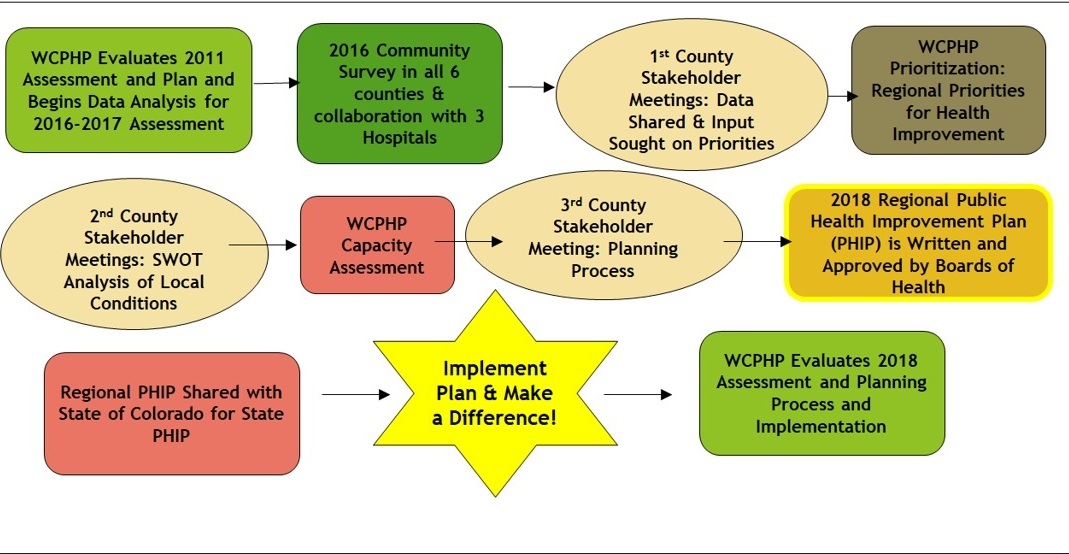Region 10 2016 Health Assessment Process
Public Health Improvement Plan
The West Central Public Health Partnership (Region 10)
The West Central Public Health Partnership (WCPHP) was formed in 2006 with the purpose of building the infrastructure of the public health system and making local public health agencies more effective and efficient. The WCPHP includes Delta, Gunnison, Hinsdale, Montrose, Ouray and San Miguel Counties. Public Health assessment and planning was one of the first projects the WCPHP tackled as a region and the process continues to guide the work of the partnership. The WCPHP did a regional public health assessment in 2011 and a public health plan in 2013. This round of assessment and planning began in 2016 and was completed in 2018.
Colorado’s Public Health Act took effect in 2008, restructuring our local public health systems statewide. The act established a set of comprehensive requirements for the community assessment and planning processes. The intention of the act is to ensure both the availability and the quality of core public health services to every resident of Colorado, ultimately to improve health outcomes. To be updated every five years, local public health agencies are responsible for planning, implementing and evaluating community needs to increase the efficiency and effectiveness of the public health system and create a Community Health Assessment (CHA) and a Community Health Improvement Plan (CHIP).
The health assessment and planning process included many steps and followed the Colorado Health Assessment and Planning System. The assessment steps included evaluation of the prior health assessment and planning process, data analysis, review and sorting of secondary data by the WCPHP Health Planner and Coordinator. They also worked with partners at local hospitals to collect primary data from a community health survey, and reviewed data with stakeholders and the WCPHP. Assessment and prioritization continued through conducting local stakeholder meetings to collect data on the top five health concerns in each of the 6 counties, which followed the presentation of a health data report to the community. The WCPHP, as the core planning team for the Public Health Improvement Planning process, then reviewed data and completed the prioritization process to choose the three regional health priorities. In 2018 the planning process took place, with strategy areas identified and an Action Plan for Year 1, 2019, created.
Process
In 2016, the WCPHP began another regional health assessment and planning process. The health assessment process included:
analysis of local and regional level health data,
community surveys,
hospital input,
and stakeholder meetings in all six counties:
Using a prioritization matrix that combined the data and input from these meetings, the WCPHP identified three priority areas:
Following the identification of the health priorities for the region, the WCPHP held community planning meetings for each of the three priority areas. Through a SWOT (Strengths, Weaknesses, Opportunities, Threats) analysis process the group identified areas ripe for action. This information combined with priority specific regional planning meetings and a capacity assessment of the six public health agencies resulted in the development of the WCPHP Public Health Improvement Plan.
SWOT Analysis Results:
WCPHP Regional Capacity Assessment PowerPoint | PDF
Kansas Foundational Public Health Services Capacity Assessment | PDF
Overview of Regional Assessment and Planning Process
Health Equity and Health Access
http://hogg.utexas.edu/3-things-to-know-health-equity
In addition, the WCPHP recognizes that health inequity exists within our region. Region 10 stakeholders identified priority populations including: early childhood and youth, elderly, immigrants, low income residents, LGBTQ, and geographically isolated residents.
The WCPHP uses the social determinants of health, a health equity framework, to address and attempt to understand health inequities in our populations as a means to increase health outcomes and access to care.
In order to improve health outcomes for our community, the WCPHP also recognizes that our priority areas must be addressed through the context of both health equity and health access.


